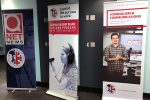Low voter turnout is becoming a trend
by Mike Morris
Voter turnout for the fall election for student leaders for the fall semester last week at Loyalist College to elect student leaders was very low.
The election was held over the course of two days last week. The winners were Ryan Finch for Building Sciences and Skills, Chantel Johnston for First Year Leader, and Alyssa Giallonardo for Media Studies. Building Sciences and Skills, First Year Leader and Media Studies were the only leadership positions available after the winter election from the previous year.
A total of only 11% of students voted in this year’s student leader election for the fall semester. There are two elections each year, one for the fall semester and one for the winter semester.
Low voter turnout is a trend for fall, and winter, elections. In the 2009-2010 year fall turnout was 14%, and the winter turnout was eight %. The 2010-2011 fall turnout was 11%, while the winter turnout was eight % that year. In the 2011-2012 year the fall turnout was 12%, while the winter turnout was 13%.
Nancy Simpson, the election’s general returning officer, said “It’s usually actually around the eight to 12%, so 11% right around where it usually is.”
Mason Reid is a Second Year Civil Engineering student. He said he didn’t vote because he had other things to do. Bernardo Cruz, from the same year and program as Reid, said he didn’t vote because he forgot about the election.
Dylan Hall is a First Year Radio student. He voted because his roommate was a first year representative, which is how he heard about the election. Fellow first year Radio student Brody Telford didn’t vote because he didn’t know there was an election last week.
Simpson thinks it was such a low voter turnout this fall because students didn’t take the time they were given to learn about the candidates, when they had enough time and resources for learning about them.
She said that the election was advertised through posters, a Facebook page, an e-newsletter, magnets, and the school’s campus website, which means students had multiple ways to learn about the candidates and election.
 Print This Post
Print This Post






